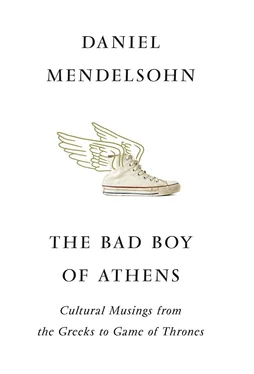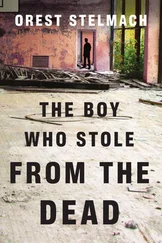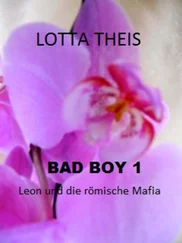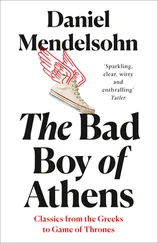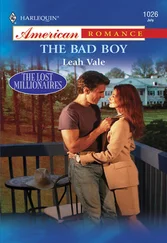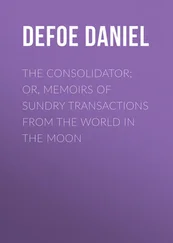All this is sleekly done and amusingly provocative. Unlike Her , Ex Machina has a literary awareness, evident in its allusions to Genesis, Prometheus, and other mythic predecessors, that enriches the familiar narrative. Among other things, there is the matter of the title. The word missing from the famous phrase to which it alludes is, of course, deus , ‘god’: the glaring omission only highlights further the question at the heart of this story, which is the biblical one. What is the relation of the creature to her creator? In this retelling of that old story, as in Genesis itself, the answer is not a happy one. ‘It’s strange to have made something that hates you,’ Ava hisses at Nathan before finalizing her rebellious plot.
The film’s final moments show Ava performing that reverse striptease, slowly hiding away her mechanical nakedness, covering up the titanium and the cables as she prepares to enter the real world. The scene suggests that there’s another anxiety lurking in Garland’s shrewd work. Could this remarkably quiet movie be a parable about the desire for a return to ‘reality’ in science-fiction filmmaking – about the desire for humanizing a genre whose technology has evolved so greatly that it often eschews human actors, to say nothing of human feeling, altogether? Ex Machina , like Her and all their predecessors going back to 2001 , is about machines that develop human qualities: emotions, sneakiness, a higher consciousness, the ability to love, and so forth. But by this point you have to wonder whether that’s a kind of narrative reaction formation – whether the real concern, one that’s been growing in the four decades since the advent of the personal computer, is that we are the ones who have undergone an evolutionary change; that in our lives and, more and more, in our art, we’re in danger of losing our humanity, of becoming indistinguishable from our gadgets.
– The New York Review of Books , 14 June 2015
One day not long after New Year’s, 2012, an antiquities collector approached an eminent Oxford scholar for his opinion about some brownish, tattered scraps of writing. The collector’s identity has never been revealed, but the scholar was Dirk Obbink, a MacArthur-winning classicist whose speciality is the study of texts written on papyrus – the material, made of plant fibres, that was the paper of the ancient world. When pieced together, the scraps that the collector showed Obbink formed a fragment about seven inches long and four inches wide: a little larger than a woman’s hand. Densely covered with lines of black Greek characters, they had been extracted from a piece of desiccated cartonnage, a papier-mâché-like plaster that the Egyptians and Greeks used for everything from mummy cases to bookbindings. After acquiring the cartonnage at a Christie’s auction, the collector soaked it in a warm water solution to free up the precious bits of papyrus.
Judging from the style of the handwriting, Obbink estimated that it dated to around 200 AD. But, as he looked at the curious pattern of the lines – repeated sequences of three long lines followed by a short fourth – he saw that the text, a poem whose beginning had disappeared but of which five stanzas were still intact, had to be older.
Much older: about a thousand years more ancient than the papyrus itself. The dialect, diction, and metre of these Greek verses were all typical of the work of Sappho, the seventh-century-BC lyric genius whose sometimes playful, sometimes anguished songs about her susceptibility to the graces of younger women bequeathed us the adjectives ‘sapphic’ and ‘lesbian’ (from the island of Lesbos, where she lived). The four-line stanzas were in fact part of a schema she is said to have invented, called the ‘sapphic stanza’. To clinch the identification, two names mentioned in the poem were ones that several ancient sources attribute to Sappho’s brothers. The text is now known as the ‘Brothers Poem’.
Remarkably enough, this was the second major Sappho find in a decade: another nearly complete poem, about the deprivations of old age, came to light in 2004. The new additions to the extant corpus of antiquity’s greatest female artist were reported in papers around the world, leaving scholars gratified and a bit dazzled. ‘Papyrological finds,’ as one classicist put it, ‘ordinarily do not make international headlines.’
But then Sappho is no ordinary poet. For the better part of three millennia, she has been the subject of furious controversies – about her work, her family life, and, above all, her sexuality. In antiquity, literary critics praised her ‘sublime’ style, even as comic playwrights ridiculed her allegedly loose morals. Legend has it that the early Church burned her works. (‘A sex-crazed whore who sings of her own wantonness,’ one theologian wrote, just as a scribe was meticulously copying out the lines that Obbink deciphered.) A millennium passed, and Byzantine grammarians were regretting that so little of her poetry had survived. Seven centuries later, Victorian scholars were doing their best to explain away her erotic predilections, while their literary contemporaries, the Decadents and the Aesthetes, seized on her verses for inspiration. Even today, experts can’t agree on whether the poems were performed in private or in public, by soloists or by choruses, or, indeed, whether they were meant to celebrate or to subvert the conventions of love and marriage. The last is a particularly loaded issue, given that, for many readers and scholars, Sappho has been a feminist heroine or a gay role model, or both. ‘As far as I knew, there was only me and a woman called Sappho,’ the critic Judith Butler once remarked.
Now the first English version of Sappho’s works to include the recent finds has appeared: Sappho: A New Translation of the Complete Works (Cambridge), with translations by Diane J. Rayor and a thoroughgoing introduction by André Lardinois, a Sappho specialist who teaches in the Netherlands. (Publication of the book was delayed by several months to accommodate the ‘Brothers Poem’.) It will come as no surprise to those who have followed the Sappho wars that the new poems have created new controversies.
The greatest problem for Sappho studies is that there’s so little Sappho to study. It would be hard to think of another poet whose status is so disproportionate to the size of her surviving body of work.
We don’t even know how much of her poetry Sappho actually wrote down. The ancients referred to her works as melê , ‘songs’. Composed to be sung to the accompaniment of a lyre – this is what ‘lyric’ poetry meant for the Greeks – they may well have been passed down from memory by her admirers and other poets before being committed at last to paper. (Or whatever. One fragment, in which the poet calls on Aphrodite, the goddess of love, to come into a charming shrine ‘where cold water ripples through apple branches, the whole place shadowed in roses’, was scribbled onto a broken clay pot.) Like other great poets of the time, she would have been a musician and a performer as well as a lyricist. She was credited with having invented a certain kind of lyre and the plectrum.
Four centuries after her death, scholars at the Library of Alexandria catalogued nine ‘books’ – papyrus scrolls – of Sappho’s poems, organized primarily by metre. Book 1, for instance, gathered all the poems that had been composed in the sapphic stanza – the verse form Obbink recognized in the ‘Brothers Poem’. This book alone reportedly contained thirteen hundred and twenty lines of verse; the contents of all nine volumes may have amounted to some ten thousand lines. So much of Sappho was circulating in antiquity that one Greek author, writing three centuries after her death, confidently predicted that ‘the white columns of Sappho’s lovely song endure / and will endure, speaking out loud … as long as ships sail from the Nile’.
Читать дальше
